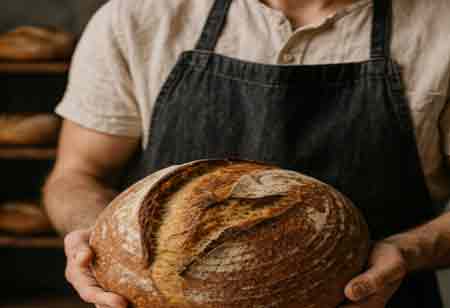Thank you for Subscribing to Food Business Review Weekly Brief
The Artisan Bread Revival and the Benefits of Handcrafted Baking
The artisan bread industry stands as a testament to the enduring appeal of handcrafted quality and traditional culinary practices in a world increasingly dominated by speed and mass production.

By
Food Business Review | Tuesday, July 15, 2025
Stay ahead of the industry with exclusive feature stories on the top companies, expert insights and the latest news delivered straight to your inbox. Subscribe today.

This sector, characterized by its dedication to natural ingredients, extended fermentation, and skilled techniques, continues to carve out a significant and growing niche within the broader bakery market. A deep dive into the current landscape reveals an ecosystem with examples such as the rise of small-scale artisan bakeries, the increasing popularity of bread-making workshops, and the growing number of consumers seeking unique bread varieties. This ecosystem is driven by evolving consumer preferences and a renewed appreciation for authentic food experiences.
Emerging Trends in Artisan Bread Production
The artisan bread sector has evolved significantly in recent years, with several innovative trends shaping how these loaves are made and consumed. Many artisan bakers are sourcing these grains locally and milling them fresh to preserve nutrients and flavor. This farm-to-oven approach strengthens local economies, reduces environmental impact, and reinforces the connection between producers and consumers. Another prominent trend is the growing popularity of sourdough bread, which uses natural fermentation and offers digestive and nutritional advantages. Sourdough fermentation helps break down gluten and phytic acid, making nutrients more bioavailable and the bread gentler in the gut. As consumers become more health-conscious, sourdough has become a flagship product in artisan bakeries. Additionally, innovation in baking methods is enabling bakers to refine traditional techniques while maintaining quality and consistency.
Many use advanced temperature control systems for fermentation, stone hearth ovens for better crust development, and hydration experiments to improve crumb structure. At the same time, digital tools are helping small bakeries reach broader audiences through online ordering, subscription services, and direct-to-consumer models. Social media platforms also play a vital role, allowing bakers to showcase their process and engage with a growing community of bread enthusiasts. These trends demonstrate how artisan bread production is embracing both tradition and innovation to meet evolving consumer expectations.
Benefits Beyond the Crust
Artisan bread offers a range of benefits that go beyond its visual and textural appeal. Nutritionally, it is often superior to mass-produced bread because it uses whole ingredients, minimal processing, and natural fermentation. The long fermentation process, especially in sourdough, helps predigest the starches and proteins in the flour, making the bread easier to digest and potentially reducing sensitivity for some individuals.
The use of whole grains and ancient flours also boosts the nutritional profile by providing fiber, antioxidants, and essential vitamins and minerals. These elements support gut health, regulate blood sugar, and contribute to overall wellness. From a sensory perspective, artisan bread offers a richer, more satisfying experience. The crust is typically well-developed, offering a satisfying crunch, while the interior is soft, moist, and filled with irregular air pockets that reflect careful fermentation and hand shaping.
Beyond health and flavor, artisan bread plays a decisive role in building local food communities. Small bakeries often partner with regional farms and mills, creating a supply chain rooted in locality and sustainability. Customers can trace the origins of their bread, talk to the baker, and even attend workshops to learn the craft themselves. These human connections turn a simple loaf into a symbol of trust, community, and shared values. Many artisan bakeries also reinvest in their communities, offer apprenticeships, and serve as gathering spots where people can connect over a shared appreciation for quality food. In this way, artisan bread acts as nourishment for the body but also as a tool for community engagement and cultural preservation.
Expanding Horizons: Distribution and Future Outlook
The distribution landscape for artisan bread producers is multifaceted. While independent neighborhood bakeries remain a cornerstone, often fostering strong community ties and offering a direct connection to the craft, the sector is also expanding into broader retail channels. Supermarkets are increasingly integrating in-store artisan bakeries or sourcing from local producers to cater to consumer demand for fresh, high-quality options. The rise of e-commerce and direct-to-consumer models has further revolutionized accessibility, allowing artisan bakers to reach a wider audience beyond their immediate geographical vicinity through online marketplaces and subscription services. This digital expansion has been particularly impactful in recent years, allowing for greater convenience and broadening consumer reach.
The future of the artisan bread industry appears promising. The underlying consumer desire for quality, authenticity, and health-conscious choices shows no signs of abating. The emphasis on sustainable practices, including the sourcing of local and organic ingredients, and efforts to minimize waste throughout the production and delivery process, is gaining increasing importance. The influence of social media platforms continues to amplify the appeal of visually stunning and unique baked goods, providing artisan producers with powerful avenues for storytelling and market engagement. As consumers continue to seek more refined and personalized culinary experiences, artisan bread, with its blend of tradition, innovation, and inherent quality, is exceptionally well-positioned for sustained growth and evolution within the global food landscape.






